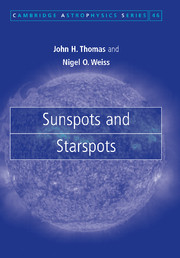Book contents
- Frontmatter
- Contents
- Preface
- 1 The Sun among the stars
- 2 Sunspots and starspots: a historical introduction
- 3 Overall structure of a sunspot
- 4 Fine structure of the umbra
- 5 Fine structure of the penumbra
- 6 Oscillations in sunspots
- 7 Sunspots and active regions
- 8 Magnetic activity in stars
- 9 Starspots
- 10 Solar and stellar activity cycles
- 11 Solar and stellar dynamos
- 12 Solar activity, space weather and climate change
- 13 The way ahead
- Appendix 1 Observing techniques for sunspots
- Appendix 2 Essentials of magnetohydrodynamic theory
- References
- Index
2 - Sunspots and starspots: a historical introduction
Published online by Cambridge University Press: 28 October 2009
- Frontmatter
- Contents
- Preface
- 1 The Sun among the stars
- 2 Sunspots and starspots: a historical introduction
- 3 Overall structure of a sunspot
- 4 Fine structure of the umbra
- 5 Fine structure of the penumbra
- 6 Oscillations in sunspots
- 7 Sunspots and active regions
- 8 Magnetic activity in stars
- 9 Starspots
- 10 Solar and stellar activity cycles
- 11 Solar and stellar dynamos
- 12 Solar activity, space weather and climate change
- 13 The way ahead
- Appendix 1 Observing techniques for sunspots
- Appendix 2 Essentials of magnetohydrodynamic theory
- References
- Index
Summary
In that part of the sky which deserves to be considered the most pure and serene of all – I mean in the very face of the Sun – these innumerable multitudes of dense, obscure, and foggy materials are discovered to be produced and dissolved continually in brief periods. Here is a parade of productions and destructions that does not end in a moment, but will endure through all future ages, allowing the human mind time to observe at pleasure and to learn those doctrines which will finally prove the true location of the spots.
Galileo GalileiIn this chapter we offer a brief historical introduction to sunspots, from the earliest naked-eye observations up to the remarkable advances in high-resolution observations and numerical simulations of recent years. We also discuss early speculations about starspots and their first observational detections. While we aim to give a balanced account, covering both observations and theory, our presentation does not follow a strict chronological path, but is instead arranged by topic. We do, however, provide a list of major advances in strict chronological order at the end of this chapter.
Early observations of sunspots
Seasonal changes were all-important to early agrarian societies and so they naturally worshipped the Sun. Indeed, the sun-god headed the pantheon in many cultures, ranging from Egypt to Peru. Since astronomy was also practised in these cultures, it seems likely that sunspots must occasionally have been detected with the naked eye, which is possible when the Sun is low on the horizon and partially obscured by dust storms, volcanic dust or smoke.
- Type
- Chapter
- Information
- Sunspots and Starspots , pp. 15 - 37Publisher: Cambridge University PressPrint publication year: 2008



